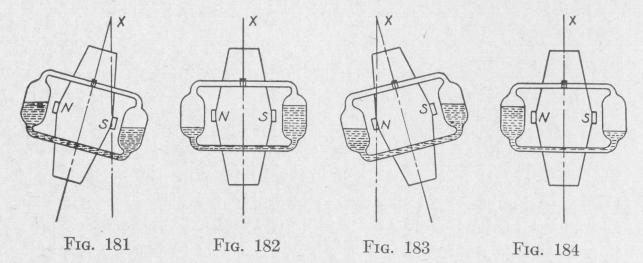230 NAVIGATIONAL COMPASSES
there will be equal amounts of oil in the two reservoirs, Fig. 181. Since oil is flowing from the upper reservoir to the lower, the distance between the center of gravity of the pendulous system and the vertical line through its axis of vibration is being diminished. Hence the torque urging the pendulous system toward the equilibrium position is being diminished faster than it would be if the oil were not flowing. By the time the north-seeking end of the spin-axle has reached its maximum displacement toward the west and the spin-axle is horizontal, the oil has reached its maximum height in the southern reservoir, Fig. 182.
At the end of another quarter vibration of the pendulous system, Fig. 183, the spin-axle is in the meridian plane, the northseeking end is dipping below the horizontal and the quantities of oil in the two reservoirs are equal. During this motion, the oil in the reservoirs diminishes the pendulous effect of the pendulous system and the spin-axle dips more slowly than it would have done if the oil were not flowing. By the time that the spin-axle again has become horizontal, Fig. 184, and its north-seeking end has reached its maximum displacement toward the east, the oil has risen in the northern reservoir to its maximum height. During this motion, the torque urging the pendulous system toward the equilibrium position is being diminished faster than it would be if the oil were not flowing. Consequently the amplitude of swing toward the east across the meridian plane is less than it would be if the oil were not flowing.
It is left as an exercise for the student to show that when the flow of liquid is adjusted as above specified, then the periodic torque acting on the gyro due to the surging liquid is in nearly opposite phase to the angular velocity of the tilting spin-axle.
THE ANSCHUTZ GYRO-COMPASS 231
This is the condition of nearly maximum damping (Arts. 25 and 27).
138. The Meridian-Steaming Error. - The meridian-steaming or north-steaming error occurs whenever a gyro-compass is being carried with a velocity which has a meridian component, that is whenever the ship is steaming on any course except directly east or west.
The magnitude of this error depends upon the course, the speed, and the latitude. As it does not depend upon the design of the instrument, it cannot be avoided. Its magnitude under various conditions can be computed and allowed for. A table of values of the meridian-steaming error is attached to the Anschutz compass. The errors may be taken account of by moving the lubber ring of the master compass and of the repeaters through the angle corresponding to the known course, speed, and latitude.
In northern latitudes the north-seeking end of the axle of a gyro-compass should tilt upward, and in southern latitudes it should tilt downward, through just the proper angle to cause the axle to precess toward the meridian plane at the rate required to keep the axle in the meridian plane. Any opposition to the proper tilting of the gyro-axle produced by damping will cause the rate of precession to be less than that required to keep the gyro-axle in the meridian plane. The settling position will be at an angle to the meridian plane called the latitude error.
The methods of damping the vibrations of the sensitive element of the Anschutz gyro-compass of 1926 do not reduce the tilt required, at the given latitude, to cause the axis of the sensitive element to precess into the meridian plane. In fact, the tilt must be greater than it would need to be if the damping device were not used, before the reduced effective pendulousness of the sensitive element will generate the necessary rate of precession at the particular latitude. There is no torque opposing the precession. Consequently, any latitude error is avoided (Art. 110).
139. Prevention of the Ballistic Deflection Error. - When a ship is steaming in any direction except on an east-west heading, the gyro-compass is deflected from the meridian plane by an angle called the meridian-steaming or north-steaming error (Art. 111). The resting position of the north-south line of the sensitive system depends upon the latitude and the meridian component of the velocity of the ship. If the velocity of the ship be changed either in direction or in magnitude, the north-south line of the sensitive
